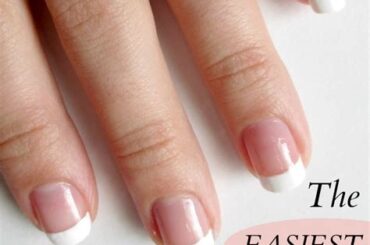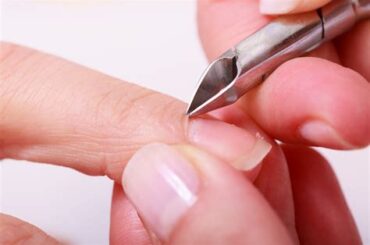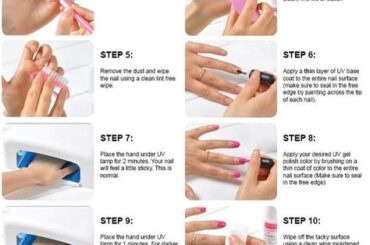Understanding Different Nail Types
When it comes to nail art, the type of nails you have can greatly impact the final result. Not all nails are the same, and understanding the different nail types is crucial for achieving the best nail art designs. Whether you have natural nails or artificial enhancements, each nail type has its own characteristics and requirements that need to be considered. Let’s delve into the world of nail types and explore how they can influence your nail art!
First, let’s start with natural nails. Natural nails are the ones you were born with, and they come in various types such as dry, brittle, or oily. Dry nails tend to be more prone to breakage and splitting, so extra care should be taken to keep them moisturized and hydrated. On the other hand, brittle nails are often weak and easily breakable, requiring strengthening treatments and protective nail products. Oily nails, on the contrary, have excessive natural oils that can affect the longevity of nail polish and designs. Understanding the characteristics of your natural nails will help you choose the right nail products for optimal results.
If you prefer artificial nail enhancements like acrylic or gel nails, each of these types also requires specific attention. Acrylic nails are known for their durability and strength, making them a popular choice for nail art enthusiasts. However, they can also be thick and may feel heavier on the nails. On the other hand, gel nails are more flexible and have a natural-looking appearance. They are less likely to chip but may require more maintenance to keep them looking fresh.
Now that we’ve covered the basics of natural and artificial nails, let’s discuss the effects of different nail types in nail art. The texture and condition of your nails play a significant role in how the nail polish adheres to your nails, how long it lasts, and how well embellishments stay in place. For example, if you have ridges on your nails, they can affect the smoothness and overall appearance of your nail art design. By understanding how your nail type interacts with nail polish and other nail art materials, you can make better choices when it comes to selecting products and techniques.
In order to achieve long-lasting nail art, it’s essential to consider your nail type. If you have weak or brittle nails, using strengthening treatments and base coats can help in preventing breakage and improving the longevity of your nail art. Similarly, if you have oily nails, using a good quality nail primer can aid in better adhesion of nail polish and designs. Being aware of your nail type and its specific needs will ensure that your nail art stays intact for longer periods.
In conclusion, understanding the different nail types is crucial for any nail art enthusiast. Whether you have natural nails or artificial enhancements, each nail type has its own characteristics and requirements that need to be considered. By taking into account your nail type, you can make informed decisions when it comes to selecting nail products and techniques. So, next time you’re planning your nail art, take a moment to understand your nail type and enhance your nail designs accordingly!
Choosing the Right Nail Type for Nail Art
Nail art has become increasingly popular in recent years, allowing individuals to express their creativity and style through intricate designs and patterns on their nails. However, one crucial aspect of achieving the perfect nail art is choosing the right nail type. With so many different options available, it can be overwhelming to know which one is best suited for your desired design. In this blog post, we will explore the various nail types and provide tips on how to choose the right one for your next nail art masterpiece.
When it comes to nail types, there are several options to consider. The most common ones include natural nails, gel nails, acrylic nails, and dip powder nails. Natural nails are your own nails without any artificial enhancements. They are the most low-maintenance option but may not provide the best base for intricate designs. Gel nails are known for their durability and flexibility, making them a popular choice for nail art enthusiasts. They require UV or LED curing to harden and can last up to three weeks. Acrylic nails, on the other hand, are created by applying a mixture of liquid monomer and powder polymer onto the nails. They are known for their strength and longevity, making them ideal for nail art that requires a solid foundation. Lastly, dip powder nails involve dipping the nails into colored powder and sealing them with a protective top coat. They are known for their natural look and are less damaging to the nails compared to other options.
So, how do you choose the right nail type for your nail art? Firstly, consider the design you have in mind. For intricate and delicate designs, gel nails or acrylic nails are often the best choice as they provide a smooth and sturdy surface. If you prefer a more natural look, dip powder nails can be a great option. Secondly, think about the durability you desire. If you want your nail art to last for weeks without chipping or lifting, gel nails or acrylic nails are preferable. However, if you prefer to change your nail art frequently, natural nails or dip powder nails may be more suitable since they can be easily removed without causing damage. Lastly, consider your lifestyle and daily activities. If you have a hands-on job or participate in activities that could potentially damage your nails, opting for a stronger nail type like gel nails or acrylic nails can provide extra protection.
To summarize, choosing the right nail type is essential for achieving the perfect nail art. Consider the intricacy of your design, the desired durability, and your lifestyle when making your decision. Whether you choose natural nails, gel nails, acrylic nails, or dip powder nails, each type offers its own advantages and can enhance your nail art in different ways. Experiment with different nail types to find the one that suits your style and allows your creativity to shine through!
Enhancing Nail Art with Nail Type Selection
When it comes to creating stunning nail art, the right nail type selection can make all the difference. Understanding different nail types is essential for achieving the desired look and ensuring long-lasting results. With various options available, it can be overwhelming to choose the right nail type. However, by exploring the effects of different nail types in nail art and enhancing your designs accordingly, you can elevate your nail art game to new heights.
One of the first steps in enhancing nail art with nail type selection is to understand the different options available. Natural nails, also known as your own nails, are a popular choice as they provide a blank canvas for creativity. However, they may have limitations in terms of length and strength. Gel nails are another option that offers flexibility and durability, making it ideal for intricate designs. Acrylic nails are known for their strength and versatility, allowing for various nail shapes and designs. Each nail type has its advantages and drawbacks, so it’s important to consider your preferences and needs before making a decision.
Once you’ve chosen the right nail type for your nail art, it’s time to dive into the world of design possibilities. One way to enhance your nail art is through the use of color. Whether you opt for a bold, vibrant shade or a soft, elegant pastel, the color you choose can greatly impact the overall look of your nail art. Consider experimenting with different shades, gradients, or even nail polish effects, such as metallic or holographic finishes, to take your designs to the next level.
In addition to color, the shape of your nails can also enhance your nail art. From classic round nails to trendy stiletto or coffin-shaped nails, the shape you choose can create a unique and eye-catching style. Certain nail shapes may lend themselves better to certain designs, so it’s worth experimenting with different shapes to find the perfect match for your nail art ideas.
Finally, don’t forget about the finishing touches that can truly enhance your nail art. Adding nail accessories such as studs, rhinestones, or decals can instantly elevate your design and add a touch of glamour. Furthermore, nail techniques such as ombre, marble, or foil can create stunning effects that will make your nail art stand out. Don’t be afraid to get creative and try new techniques to enhance your overall nail art aesthetic.
- Understand the different nail types available
- Choose the right nail type based on your preferences and needs
- Experiment with different colors, gradients, and finishes
- Consider the shape of your nails and how it complements your design
- Add finishing touches such as nail accessories and techniques
| Nail Type | Advantages | Drawbacks |
|---|---|---|
| Natural nails | Provide a blank canvas for creativity | May have limitations in length and strength |
| Gel nails | Flexible and durable | Requires curing under UV or LED light |
| Acrylic nails | Strong and versatile | Require regular maintenance and can damage natural nails if not applied properly |
Exploring the Effects of Different Nail Types in Nail Art
Nail art has become a popular trend in recent years, with people of all ages and genders experimenting with different designs and colors to express their creativity. But did you know that the type of nail you have can actually have an effect on the final outcome of your nail art? In this blog post, we will be exploring the effects of different nail types in nail art and how you can choose the right type to enhance your designs.
Firstly, let’s talk about short nails. Short nails may seem like a limitation when it comes to nail art, but that’s not necessarily the case. In fact, short nails can be quite versatile and can still create stunning nail art designs. By using bold colors and intricate patterns, you can draw attention to your short nails and make them look longer and more elegant. Don’t be afraid to experiment with different shapes and styles to find what works best for you.
Next, let’s move on to long nails. Long nails provide a larger canvas for nail art, giving you more space to play with different designs and details. You can create intricate patterns, add 3D elements, or even experiment with different textures. The possibilities are endless! Just remember to take proper care of your long nails to prevent breakage and maintain their health.
Lastly, we have natural nails. Natural nails refer to nails that have not been enhanced with extensions or acrylics. While natural nails may not provide as much length or durability as artificial nails, they have their own unique charm. Natural nails can create a more understated and minimalist look, perfect for those who prefer a more subtle nail art style. You can still experiment with different colors and designs, but keep in mind that you may need to take extra care to prevent chipping or peeling.
To summarize, the type of nail you have can indeed have an effect on your nail art designs. Short nails can be bold and attention-grabbing, while long nails provide more space for intricate details. Natural nails offer a more understated and minimalist look. Whatever nail type you have, don’t be afraid to experiment and have fun with your nail art. After all, it’s all about expressing your creativity and personal style!
- Short nails can be versatile and create stunning designs
- Long nails provide a larger canvas for more intricate designs
- Natural nails offer a more understated and minimalist look
| Nail Type | Advantages |
|---|---|
| Short Nails | Versatile, can create bold designs |
| Long Nails | More space for intricate details |
| Natural Nails | Understated and minimalist look |
Achieving Long-Lasting Nail Art Based on Nail Type
When it comes to nail art, one of the key factors to consider is the nail type. Understanding the different nail types and choosing the right one for your desired nail art can significantly impact how long your nail design will last. Different nail types have different characteristics that can affect the durability and maintenance of your nail art. So, let’s dive into the various nail types and explore how they can enhance the longevity of your manicure.
Listed below are the different nail types:
- Natural Nails: These are the nails that haven’t been enhanced with artificial extensions or overlays. Natural nails tend to be flexible and more prone to breaking or chipping.
- Acrylic Nails: Acrylic nails are the most popular artificial nail type. They are made by combining liquid monomer and powdered polymer to create a durable and robust nail extension. Acrylic nails are known for their strength and long-lasting nature.
- Gel Nails: Gel nails are created using a gel polish that is cured under a UV or LED lamp. They provide a natural-looking, glossy finish and are generally more flexible than acrylic nails. Gel nails can last for several weeks with proper care.
Each nail type has its advantages and considerations to keep in mind for achieving long-lasting nail art:
| Nail Type | Advantages | Considerations |
|---|---|---|
| Natural Nails | Look and feel natural | Prone to breakage and chipping |
| Acrylic Nails | Strong and durable | Require maintenance and regular fills |
| Gel Nails | Natural-looking and glossy | May require a UV or LED lamp for curing |
Based on your nail type, certain nail art techniques or products may work better than others. For example, gel nail polish is more compatible with gel nails as it adheres better and withstands daily wear and tear. On the other hand, acrylic nails provide a solid foundation for intricate 3D nail art designs.
To make your nail art last longer, regardless of your nail type, it’s essential to follow proper nail care practices. This includes avoiding harsh chemicals, regularly moisturizing your cuticles, wearing gloves while doing chores, and touching up any chipped areas promptly.
Ultimately, achieving long-lasting nail art is a combination of selecting the right nail type, using compatible products, and practicing good nail care routines. By understanding the characteristics of different nail types and tailoring your nail art technique accordingly, you can enjoy beautiful, durable manicures that stand the test of time.
Frequently Asked Questions
What are the different types of nails for nail art?
There are several types of nails that can be used for nail art, including natural nails, acrylic nails, gel nails, and press-on nails.
How do I choose the right nail type for my nail art?
When selecting the right nail type for your nail art, consider factors such as your desired nail shape, the length you want to achieve, and the durability you need. Some nail types may be better suited for certain designs or techniques.
How can I enhance my nail art with the selection of the right nail type?
By choosing the right nail type, you can enhance your nail art in various ways. For example, gel nails or acrylic nails provide a strong base for intricate designs, while press-on nails offer convenience and easy removal for experimenting with different styles.
What effects do different nail types have on nail art?
Different nail types have different effects on nail art. For instance, gel nails can create a glossy finish and are great for 3D designs, while acrylic nails are known for their sturdiness and ability to hold embellishments. Natural nails may require more maintenance but can provide a more natural look.
How can I achieve long-lasting nail art based on nail type?
To achieve long-lasting nail art, it is important to properly prepare and maintain your nails based on their type. This includes regular filing, shaping, and cuticle care. Additionally, using the appropriate nail products and techniques specific to the chosen nail type can help ensure the longevity of your nail art.
Can I combine different nail types in a single nail art design?
Yes, combining different nail types in a single nail art design is definitely possible. Many nail artists mix and match different nails types to create unique and eye-catching designs. Just ensure that the chosen nail types are compatible and that proper techniques are used to secure them together.
Are there any limitations or challenges when using certain nail types for nail art?
Yes, certain nail types may have limitations or pose challenges when used for nail art. For example, natural nails may be more prone to breakage, while some nail types like press-on nails may not withstand heavy wear and tear. It’s important to consider these factors and choose the right nail type accordingly.





